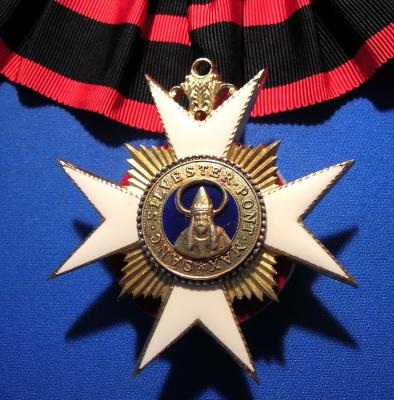President FIAMC (2014-2018)
The Order of Saint Sylvester (Ordo Sancti Sylvestri Papae), originally united with the Order of the Golden Spur, was formally constituted on 7 February 1905 by Pope Saint Pius X in his motu proprio, Multum ad excitandos. From that time, the united order became two orders, the Order of Saint Sylvester and the Order of the Golden Spur. Since the 1905 reforms of Pope Saint Pius X, the are four grades.
Since 1994 women have been admitted to the Order as Dames in the same grades and divisions as men. It was also Saint Pius X who gave Papal knights a place of honor in Papal processions and ecclesiastical ceremonies.

As with all Orders of the Holy See, there is no set method of nomination for this Order. The Holy See is free to nominate and award in any manner in which she sees fit. However, awards of the Order of Saint Sylvester are typically made on the recommendation of Diocesan Bishops or Archbishops or Nuncios for special merit or service.
If it is processed through the local Bishop, then the usual procedure is for that Bishop to nominate the candidate through the appropriate Apostolic Nuncio, who then forwards the recommendation to the Cardinal Secretary of State in Rome. Awards are also sometimes made on specific recommendation of members of the Roman Curia. Specific procedures can vary. Upon approval, a diploma is issued in Latin (with the candidate’s forenames also translated into Latin where possible), and it is signed in almost every case on behalf of the Roman Pontiff by the Secretary of State of the Vatican.
Before the 1905 reforms of Pope Saint Pius X, the Order was known as the Order of the Golden Spur, under the patronage of Saint Sylvester, one of the Order’s supposed founders. “The members have no privileges beyond that of wearing a decoration which consists of a gold enamelled Maltese cross with the image of St. Sylvester on one side and the other the inscription: ‘1841 Gregorius XVI restituit.'” (Moeller, C. (1912). Order of Saint Sylvester. The Catholic Encyclopedia.) Even though Vatican reforms no longer confer a special status on Papal knights, the receipt of a Papal knighthood ought to serve as an impetus for service on the part of the recipient. Sometimes non-Catholics receive the honor (Guy Stair Sainty. “History of the Papal Orders”. Burke’s Peerage.) It is also interesting to note that the Knights of Saint Sylvester retain the privilege of riding a horse inside Saint Peter’s in Rome.
The insignia of the Order of Saint Sylvester follows the standards for Papal decorations. The Grand Cross is worn suspended from a broad ribbon over the right shoulder, with a star worn on the left breast. The two grades of Commander wear the badge suspended from a ribbon about the neck, the Knight of the 2nd class also wearing a star. Simple Knights wear the badge from a ribbon drape on the left breast. The uniform has a black jacket and a plumed hat and is worn with a sword. It becomes more elaborate with increased rank. Ladies do not wear the uniform. The ribbon for a Dame Grand Cross is more narrow than that of the Knight Grand Cross.
The Order may be presented simply by the receipt of the diploma, or there may be a simple or formal investiture. This is at the discretion of the nominating Bishop. Only rarely are ceremonies conducted in the Vatican, and usually this is for major public figures, heads of state, or other diplomatic officials.






